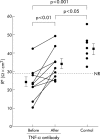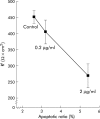Downregulation of epithelial apoptosis and barrier repair in active Crohn's disease by tumour necrosis factor alpha antibody treatment
- PMID: 15306588
- PMCID: PMC1774168
- DOI: 10.1136/gut.2003.036632
Downregulation of epithelial apoptosis and barrier repair in active Crohn's disease by tumour necrosis factor alpha antibody treatment
Erratum in
- Gut. 2004 Nov;53(11):1722
Abstract
Background and aims: Barrier dysfunction is an important feature contributing to inflammation and diarrhoea in Crohn's disease (CD). Recently, tumour necrosis factor alpha (TNF-alpha) antibodies were recognised as effective in steroid refractory CD. The aim of this study was to characterise the effects of this therapy on the epithelial barrier.
Patients and methods: Forceps biopsies were obtained from the sigmoid colon before and 14 days after TNF-alpha antibody therapy in 11 patients treated for chronic active CD (Crohn's disease activity index >150). Epithelial apoptoses were measured after terminal deoxynucleotidyl transferase mediated deoxyuridine triphosphate nick end labelling (TUNEL) and 4',6-diamidino-2-phenylindole staining. Epithelial resistance was determined by alternating current impedance analysis in miniaturised Ussing chambers. Occludin, claudin 1, and claudin 4 expression was quantified in immunoblots.
Results: The epithelial apoptotic ratio was 2.1 (0.2)% in controls and increased to 5.3 (1.0)% in CD. TNF-alpha antibody therapy decreased the apoptotic ratio to 2.9 (1.0)% (normalised in 10 of 11 patients). In parallel, epithelial resistance was lower in CD than in controls (24 (3) v 42 (3) Omegaxcm(2)) and improved to 34 (3) Omegaxcm(2) after therapy. Occludin, claudin 1, and claudin 4 were not affected by TNF-alpha antibody therapy. In support of a functional role of epithelial apoptoses in CD, a similar decrease in resistance of -40% was observed when the apoptotic rate was selectively upregulated from 2.6% to 5.4% with camptothecin in HT-29/B6 cells.
Conclusions: Epithelial apoptoses were upregulated in the colon in CD and restored to normal in 10 of 11 patients by TNF-alpha antibody therapy. This is the structural correlate of epithelial barrier dysfunction measured as epithelial resistance while expression of tight junction proteins did not contribute to this therapeutic effect.
Figures






Similar articles
-
Impairment of the intestinal barrier is evident in untreated but absent in suppressively treated HIV-infected patients.Gut. 2009 Feb;58(2):220-7. doi: 10.1136/gut.2008.150425. Epub 2008 Oct 20. Gut. 2009. PMID: 18936106
-
Interleukin-13 is the key effector Th2 cytokine in ulcerative colitis that affects epithelial tight junctions, apoptosis, and cell restitution.Gastroenterology. 2005 Aug;129(2):550-64. doi: 10.1016/j.gastro.2005.05.002. Gastroenterology. 2005. PMID: 16083712
-
Changes in expression and distribution of claudin 2, 5 and 8 lead to discontinuous tight junctions and barrier dysfunction in active Crohn's disease.Gut. 2007 Jan;56(1):61-72. doi: 10.1136/gut.2006.094375. Epub 2006 Jul 5. Gut. 2007. PMID: 16822808 Free PMC article.
-
Altered permeability in inflammatory bowel disease: pathophysiology and clinical implications.Curr Opin Gastroenterol. 2007 Jul;23(4):379-83. doi: 10.1097/MOG.0b013e32816aa392. Curr Opin Gastroenterol. 2007. PMID: 17545772 Review.
-
Therapeutic options to modulate barrier defects in inflammatory bowel disease.Dig Dis. 2009;27(4):450-4. doi: 10.1159/000233283. Epub 2009 Nov 4. Dig Dis. 2009. PMID: 19897959 Review.
Cited by
-
Tight junctions on the move: molecular mechanisms for epithelial barrier regulation.Ann N Y Acad Sci. 2012 Jul;1258:9-18. doi: 10.1111/j.1749-6632.2012.06613.x. Ann N Y Acad Sci. 2012. PMID: 22731710 Free PMC article. Review.
-
Death in the intestinal epithelium-basic biology and implications for inflammatory bowel disease.FEBS J. 2016 Jul;283(14):2720-30. doi: 10.1111/febs.13771. Epub 2016 Jun 22. FEBS J. 2016. PMID: 27250564 Free PMC article. Review.
-
Ablation of tumor necrosis factor is associated with decreased inflammation and alterations of the microbiota in a mouse model of inflammatory bowel disease.PLoS One. 2015 Mar 16;10(3):e0119441. doi: 10.1371/journal.pone.0119441. eCollection 2015. PLoS One. 2015. PMID: 25775453 Free PMC article.
-
CARD15/NOD2 is required for Peyer's patches homeostasis in mice.PLoS One. 2007 Jun 13;2(6):e523. doi: 10.1371/journal.pone.0000523. PLoS One. 2007. PMID: 17565376 Free PMC article.
-
Erythropoietin protects epithelial cells from excessive autophagy and apoptosis in experimental neonatal necrotizing enterocolitis.PLoS One. 2013 Jul 25;8(7):e69620. doi: 10.1371/journal.pone.0069620. Print 2013. PLoS One. 2013. PMID: 23936061 Free PMC article.
References
-
- Prantera C , Cottone M, Pallone F, et al. Mesalamine in the treatment of mild to moderate active Crohn’s ileitis: results of a randomized, multicenter trial. Gastroenterology 1999;116:521–6. - PubMed
-
- van Dullemen HM, van Deventer SJ, Hommes DW, et al. Treatment of Crohn’s disease with anti-tumor necrosis factor chimeric monoclonal antibody (cA2). Gastroenterology 1995;109:129–35. - PubMed
-
- Hanauer SB, Feagan BG, Lichtenstein GR, et al. Maintenance infliximab for Crohn’s disease: the ACCENT I randomised trial. Lancet 2002;359:1541–9. - PubMed
-
- Bjarnason I , MacPherson A, Hollander D. Intestinal permeability: an overview. Gastroenterology 1995;108:1566–81. - PubMed
Publication types
MeSH terms
Substances
LinkOut - more resources
Full Text Sources
Other Literature Sources
Medical
